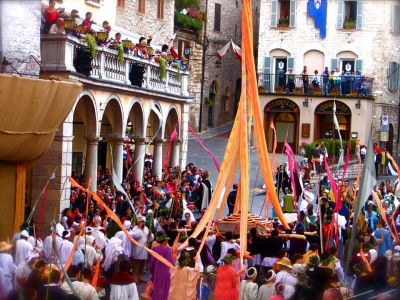Il Medioevo rivive ad Assisi ogni anno durante la prima settimana di maggio, in occasione della festa del Calendimaggio. La manifestazione riporta in vita tradizioni, usanze passate e riti propiziatori pagani che celebravano il ritorno della primavera e il rinnovarsi del ciclo della vita, diffusi presso l’antico popolo degli Umbri. Il Calendimaggio rimane oggi tra i pochi eventi a rispettare rigorosamente le fonti storiche medievali ed è celebrato dai cittadini di Assisi con un’intensa partecipazione incentrata sulla disfida tra gli abitanti della zona alta e di quella bassa attraverso lo svolgimento di scene medievali recitate, cortei in costume ed esibizioni musicali. Una giuria decreta la fazione che meglio ha magnificato la nascente Primavera.
Calendimaggio, which translates to May Day, is a day in which an annual grand celebration takes place within Italy, specifically within Assisi in the province of Perugia. The events of this festival are performed as largely and as elaborately as possible, as preparations for this single week occurs throughout the entire year. This day has a strong history behind it and, while some Italians regard it as a celebration of the arrival of spring, this event is actually used to remember a feud between the citizens of Assisi from centuries ago.
Though some may say that Calendimaggio commemorates the new spring season, it is specifically a three-day event used to honor and recreate a once-major conflict within Assisi. During the week, games and races are held for all participants. Medieval-style decorations and flags are spread throughout the town and fun battles and challenges occur on selected days. Towards the end of the week, music fills the streets as concerts and performances occur. The activities vary by day, so tourists may need to plan accordingly if they want to visit Assisi for this specific occasion, though this celebration may be a culture-shock for those not familiar with this area of Italy and its rich history.
The celebration derived from a conflict which occurred centuries ago. During the medieval era, a rivalry began between two areas of Assisi known as the Parte de Sotto, which was led by the Fiumi family, and Parte de Sopra, which was led by the Nepis family. The Sopra held the upper area of the city and the Sotto held the lower. Both families fought for power from the 14th through the 16th centuries and the conflict was not resolved until countless years passed. Today, the day is not celebrated by bloody battles, but by peaceful music, parades, performances, and competitions between the two areas of the city.
The festival begins with the blessing of the banners and then various festivities are enjoyed throughout the town as torches and flags reminiscent of the medieval era decorate the streets. The final day of the festival holds a ceremony deciding a winner after three songs are performed by both the upper and lower side of Assisi, which occurs in the Piazza del Comune. The jury decides between the two participating areas of the city and the winner is awarded the Palio. If the Maestro de Campo waves a blue handkerchief, the Parte de Sopra has won the events. And if a red handkerchief is seen, the Parte de Sotta has won. A grand feast continues throughout the night after this ceremony and then the celebration comes to an exhausting end.
This year, the Calendimaggio festival will be taking place from May 2 to May 5. Though usually a three-day event, the celebration will be held for four days. There are many fun events taking place during this week, from tug of war to archery competitions, and there is sure to be an activity for everyone to enjoy. While learning about great Italian history, one can also enjoy great Italian culture throughout the week.



